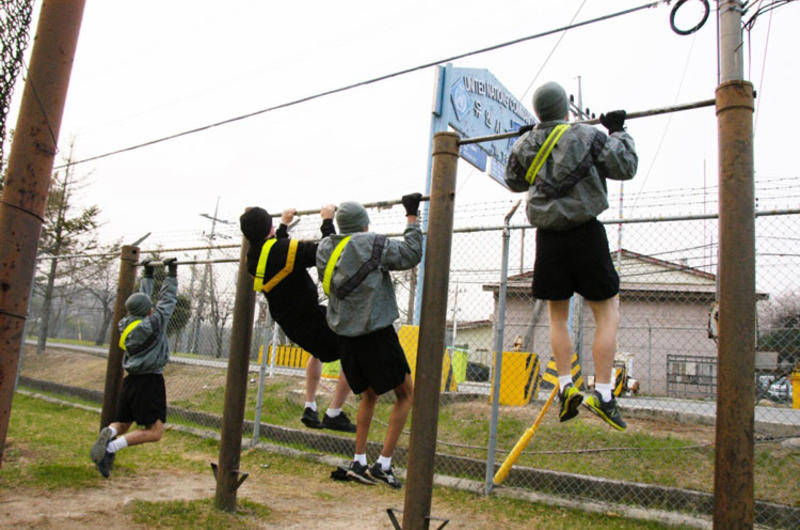US troops at Korea's DMZ guide tours, train, lead no-frills life

U.S. troops start the day with physical training at Camp Bonifas, South Korea, a few minutes' drive from the Demilitarized Zone, in April 2015. (SETH ROBSON/STARS AND STRIPES)
By SETH ROBSON | Stars and Stripes June 9, 2015
CAMP BONIFAS, South Korea — “Is anyone planning to defect?”
It’s a question that never fails to crack up visitors during tours to the Joint Security Area, where North and South Korean soldiers face off inside the Demilitarized Zone separating the rival nations.
Pfc. Joshua Dixon, 23, of Brainerd, Minn., has been asking the question of tourists for the past year as a member of the United Nations Command Security Battalion at Camp Bonifas.
“Most people laugh. But if there’s a guy who doesn’t even smile I keep my eye on him,” said Dixon, who spends about a third of his time helping run the tours, often for other servicemembers assigned to Korea.
Camp Bonifas — only a few minutes’ drive from the JSA — hosts 800 to 900 visitors each day, so escorting them is a big part of the job for the troops on the world’s most militarized border.
It’s a place where the relative calm belies the threat across the border from a belligerent country that has been developing nuclear weapons and ballistic missiles and periodically heats up tensions to a boil. The barbed-wire frontier is heavily mined and under constant scrutiny with armed foot patrols by both sides.
Like many of the U.S. soldiers at Camp Bonifas, this is Dixon’s first duty station. He enlisted in November 2013 after dropping out of an athletic studies course at the University of Minnesota Duluth.
“I was sitting in class and I checked my bank account and I was in debt,” he recalled. “I walked into the recruiting office and asked: ‘What can you do for me?’ ”
Some of the young Bonifas troops think it’s tough duty — the conditions are relatively spartan, and no families are allowed, unlike at bases further south. However, talking with noncommissioned officers and officers who have served in Iraq and Afghanistan puts things in perspective, Dixon said.
“Soldiers who haven’t been deployed think this is pretty bad, but you have to realize that it could always be worse,” he said.
Before they can run the tours, U.S. troops must memorize a 13-page-history of the Korean War along with details about what goes on at the JSA. They also some of their time on standby, ready to respond to incidents in the JSA.
There have been some high-profile incidents over the years. In 1976, North Korean troops used an ax to murder two U.S. officers, including Camp Bonifas’ namesake, Capt. Arthur Bonifas. In 1984, a firefight broke out after a Soviet defector ran into South Korea.
The U.S. soldiers share quick-reaction force duties with two South Korean military units.
When the Americans are on standby, they spend their time training. Camp Bonifas has its own shoot-house, where soldiers can practice fighting, and a pistol range, but the soldiers also train at ranges outside the post including one that has a mock-up of the JSA.
“We mostly train infantry tactics but we do some personal security detail training to make sure we can bring anyone we bring into the DMZ safely back to Camp Bonifas,” Dixon said.
Initially a Special Forces recruit, Dixon ended up a military policeman due to color blindness and an ear problem. However, recruiters for the security battalion saw something special in him when he joined at the 2nd Infantry Division in Korea and called him in for an interview.
“They were looking for guys with good PT (physical training) scores and clean military and civilian backgrounds,” he said. “They tell you it is a little harder up here and you’re under a little more restrictions, but it’s a real-world mission.”
That was enough for Dixon, who has come to love life at Camp Bonifas, even though the isolation means troops there don’t get to see much of South Korea; they must be able to get back within two hours if there’s an emergency.
Dixon’s day, like that of the other troops up north, starts with a formation on an indoor basketball court followed by physical training. As the sun came up on a recent chilly morning, he and two dozen others ran and did pull-ups and calisthenics on a baseball field to get their blood pumping.
Afterward, Dixon headed back to his barracks — it’s nothing special, but troops get their own rooms, sharing a bathroom and kitchenette with a roommate.
The dining facility is being renovated so the troops cook most meals in their rooms. The Army sent a nutritionist and a finance specialist to the base last year to teach them about cooking and shopping for healthy food, Dixon said as he fried eggs and potatoes on an electric range.
For now, the troops make runs to the commissary on Yongsan Garrison in Seoul every two weeks to stock up on groceries, although they can buy snacks from an Army and Air Force Exchange Service trailer on Camp Bonifas several days a week.
After breakfast, Dixon swapped his T-shirt and shorts for a camouflage uniform and a Joint Security Area armband, and it was off to work.
At midday, Dixon stopped at the South Korean troops’ dining facility for lunch that was typical Korean fare: pork, rice and spicy cabbage kimchi. He bumped into several South Korean soldiers with whom he has become friends.
The U.S. troops also interact with soldiers from several other nations, including New Zealand, Canada, Switzerland, Sweden and Poland, who work with the United Nations Command Military Armistice Commission.



